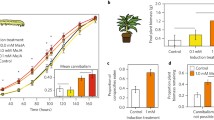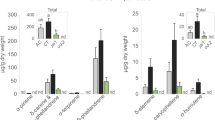Abstract
Although induced defenses are widespread in plants, the degree to which plants respond to herbivore kairomones (incidental chemicals that herbivores produce independent of herbivory), the costs and benefits of responding to cues of herbivory risk, and the ecological consequences of induced defenses remain unclear. We demonstrate that undamaged tomatoes, Solanum lycopersicum, induce defenses in response to a kairomone (locomotion mucus) of snail herbivores (Helix aspersa). Induced defense had significant costs and benefits for plants: plants exposed to snail mucus or a standard defense elicitor (methyl jasmonate, MeJA) exhibited slower growth, but also experienced less herbivory by an insect herbivore (Spodoptera exigua). We also find that kairomones from molluscan herbivores lead to deleterious effects on insect herbivores mediated through changes in plant defense, i.e., mucus-induced defenses of Solanum lycopersicum-reduced growth of S. exigua. These results suggest that incidental cues of widespread generalist herbivores might be a mechanism creating variation in plant growth, plant defense, and biotic interactions.


Similar content being viewed by others
References
Ali JG, Agrawal AA (2012) Specialist versus generalist insect herbivores and plant defense. Trends Plant Sci 17:293–302
Barker GM (ed) (2002) Molluscs as crop pests. CABI, Wallingford
Choi HW, Klessig DF (2016) DAMPs, MAMPs, and NAMPs in plant innate immunity. BMC Plant Biol 16:232
Cleland EE, Peters HA, Mooney HA, Field CB (2006) Gastropod herbivory in response to elevated CO2 and N addition impacts plant community composition. Ecology 87:686–694
Duffey SS, Felton GW (1991) Enzymatic antinutritive defenses of the tomato plant against insects. In: Hedin PA (ed) Naturally occurring pest bioregulators. American Chemical Society, Washington, DC, pp 167–197
Falk K et al (2014) The role of glucosinolates and the jasmonic acid pathway in resistance of Arabidopsis thaliana against molluscan herbivores. Mol Ecol 23:1188–1203
Farmer EE, Ryan CA (1990) Interplant communication: airborne methyl jasmonate induces synthesis of proteinase inhibitors in plant leaves. Proc Natl Acad Sci USA 87:7713–7716
Felton GW (2008) Caterpillar secretions and induced plant responses. In: Schaller A (ed) Induced plant resistance to herbivory. Springer, Stuttgart, pp 369–387
Greistorfer S et al (2017) Snail mucus—glandular origin and composition in Helix pomatia. Zoology 122:126–138
Heil M, Karban R (2010) Explaining evolution of plant communication by airborne signals. Trends Ecol Evol 25:137–144
Helms AM, De Moraes CM, Tooker JF, Mescher MC (2013) Exposure of Solidago altissima plants to volatile emissions of an insect antagonist (Eurosta solidaginis) deters subsequent herbivory. Proc Natl Acad Sci USA 110:199–204
Helms AM et al (2017) Identification of an insect-produced olfactory cue that primes plant defenses. Nature Comm 8:337
Hilker M, Meiners T (2010) How do plants “notice” attack by herbivorous arthropods? Biol Rev 85:267–280
Howe GA, Jander G (2008) Plant immunity to insect herbivores. Ann Rev Plant Bio 59:41–66
Hulme PE (1996) Herbivores and the performance of grassland plants: a comparison of arthropod, mollusc and rodent herbivory. J Ecol 84:43–51
Huot B, Yao J, Montgomery BL, He SY (2014) Growth-defense tradeoffs in plants: a balancing act to optimize fitness. Mol Plant 7:1267–1287
Karban R, Baldwin IT (1997) Induced responses to herbivory. University of Chicago Press, Chicago
Karban R, Orrock JL, Preisser EL, Sih A (2016) A comparison of plants and animals in their responses to risk of consumption. Curr Opin Plant Biol 32:1–8
Kästner J, von Knorre D, Himanshu H, Erb M, Baldwin IT, Meldau S (2014) Salicylic acid, a plant defense hormone, is specifically excreted by a molluscan herbivore. PLoS One 9:e86500
Kats LB, Dill LM (1998) The scent of death: chemosensory assessment of predation risk by prey animals. Ecoscience 5:361–394
Kempel A, Schädler M, Chrobrock T, Fischer M, van Kleunen M (2011) Tradeoffs associated with constitutive and induced plant resistance against herbivory. Proc Natl Acad Sci USA 108:5685–5689
Kennedy GG (2003) Tomato, pests, parasitoids, and predators: tritrophic interactions involving the genus Lycopersicon. Ann Rev Entomol 48:51–72
Kim J, Quaghebeur H, Felton GW (2011) Reiterative and interruptive signalling in induced plant resistance to chewing insects. Phytochemistry 72:1624–1634
Koiwa H, Bressan RA, Hasegawa PM (1997) Regulation of protease inhibitors and plant defense. Trends Plant Sci 2:379–384
Lima SL, Dill LM (1990) Behavioral decisions made under the risk of predation—a review and prospectus. Can J Zool 68:619–640
Manosalva P et al (2015) Conserved nematode signalling molecules elicit plant defenses and pathogen resistance. Nat Comm 6:7795
Meldau S, Kästner J, Von Knorre D, Baldwin IT (2015) Salicylic acid-dependent gene expression is activated by locomotion mucus of different molluscan herbivores. Comm Integ Bio 9:e28728
Mescher MC, De Moraes CM (2015) Role of plant sensory perception in plant-animal interactions. J Exp Bot 66:425–433
Motheral SM, Orrock JL (2010) Gastropod herbivore preference for seedlings of two native and two exotic grass species. Am Midl Nat 163:106–114
Ohgushi T (2005) Indirect interaction webs: herbivore-induced effects through trait change in plants. Ann Rev Ecol Evol Syst 36:81–105
Orrock JL (2013) Exposure of unwounded plants to chemical cues associated with herbivores leads to exposure-dependent changes in subsequent herbivore attack. PLoS One 8:e79900
Orrock JL et al (2015) Error management in plant allocation to herbivore defense. Trends Ecol Evol 30:441–445
Peiffer M, Tooker JF, Luthe DS, Felton GW (2009) Plants on early alert: glandular trichomes as sensors for insect herbivores. New Phytol 184:644–656
Pitt SJ, Graham MA, Dedi CG, Taylor-Harris PM, Gunn A (2015) Antimicrobial properties of mucus from the brown garden snail Helix aspersa. Br J Biomed Sci 72:174–181
Poelman EH, van Loon JAJ, Dicke M (2008) Consequences of variation in plant defense for biodiversity at higher trophic levels. Trends Plant Sci 13:534–541
Preisser EL, Bolnick DI, Benard MF (2005) Scared to death? The effects of intimidation and consumption in predator-prey interactions. Ecology 86:501–509
Schaller A (ed) (2008) Induced plant resistance to herbivory. Springer, Stuttgart
Scheiner SM, Gurevitch J (2001) Design and analysis of ecological experiments, 2nd edn. Oxford University Press, New York
Shannon RWR, Félix A-E, Poppy GM, Newland PL, van Dam NM, Hanley ME (2016) Something in the air? The impact of volatiles on mollusc attack of oilseed rape seedlings. Ann Bot 117:1073–1082
Stam JM et al (2014) Plant interactions with multiple insect herbivores: from community to genes. Ann Rev Plant Bio 65:689–713
Stout MJ, Workman KV, Bostock RM, Duffey SS (1998) Specificity of induced resistance in the tomato, Lycopersicon esculentum. Oecologia 113:74–81
Strauss SY et al (2009) Cryptic seedling herbivory by nocturnal introduced generalists impacts survival, performance of native and exotic plants. Ecology 90:419–429
Thaler JS (1999) Jasmonate-inducible plant defences cause increased parasitism of herbivores. Nature 399:686–688
Thaler JS, Stout MJ, Karban R, Duffey SS (1996) Exogenous jasmonates simulate insect wounding in tomato plants (Lycopersicon esculentum) in the laboratory and field. J Chem Ecol 22:1767–1781
Underwood N (2010) Density dependence in insect performance within individual plants: induced resistance to Spodoptera exigua in tomato. Oikos 119:1993–1999
van Hulten M, Pelser M, van Loon LC, Pieterse CMJ, Ton J (2006) Costs and benefits of priming for defense in Arabidopsis. Proc Natl Acad Sci USA 103:5602–5607
Waldbauer GG (1968) The consumption and utilization of food by insects. Adv Insect Phys 5:229–289
Weissburg M, Smee DL, Ferner MC (2014) The sensory ecology of nonconsumptive predator effects. Am Nat 184:141–157
Acknowledgements
Jessica Casper provided outstanding assistance with herbivory trials; the Damschen lab kindly provided their microbalance. This study was supported by the UW Graduate School Fall Competition Grant to JO and SG and NSF Grant MCB-1329723 to SG and WC. JO was supported by the Vilas Fellowship during a portion of this work. The Biology Department at Virginia Commonwealth University hosted JO while working on this manuscript.
Author information
Authors and Affiliations
Contributions
JO conceived the study; JO, BC, and SG designed the study; BC, PG, WC, and SS collected the data; and JO analyzed the data and drafted the manuscript; all authors contributed to revising the final manuscript.
Corresponding author
Ethics declarations
Conflict of interest
The authors declare that they have no conflicts of interest.
Additional information
Communicated by Carlos L. Ballare.
Electronic supplementary material
Below is the link to the electronic supplementary material.
Rights and permissions
About this article
Cite this article
Orrock, J.L., Connolly, B.M., Choi, WG. et al. Plants eavesdrop on cues produced by snails and induce costly defenses that affect insect herbivores. Oecologia 186, 703–710 (2018). https://doi.org/10.1007/s00442-018-4070-1
Received:
Accepted:
Published:
Issue Date:
DOI: https://doi.org/10.1007/s00442-018-4070-1




